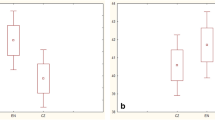Many theoretical accounts consider disgust to be a unitary emotion, although others have challenged this notion. We predict that if core disgust and socio-moral disgust are different constructs, then their co-associated elicited emotions are likely to be different, and time as well as gender are likely to differentially affect their intensity (via a greater reliance of socio-moral disgust on cognitive appraisal). To test these predictions, participants were shown photographs of core and socio-moral disgust elicitors and asked to provide a wide ranging rating of their emotional response to each at 3 time points. Each elicitor generated a significantly different emotional response. Furthermore, the disgust response to core elicitors weakened over time whereas socio-moral responses intensified. Males and females showed similar levels of disgust to socio-moral elicitors, but females showed higher levels to core elicitors. Overall, the results suggest that a different emotional construct was activated by each type of elicitor.

Similar content being viewed by others
References
Alvarado, N. (1998). A reconsideration of the structure of the emotion lexicon. Motivation and Emotion, 22, 329–344.
Angyal, A. (1941). Disgust and related aversions. Journal of Abnormal and Social Psychology, 36, 393–412.
Basinger, K. S., Gibbs, J. C., & Fuller, D. (1995). Context and the measurement of moral judgement. International Journal of Behavioral Development, 18, 537–556.
Christie, I. C., & Friedman, B. H. (2004). Autonomic specificity of discrete emotion and dimensions of affective space: A multivariate approach. International Journal of Psychophysiology, 51, 143–153.
Clore, G. L. (1994). Why emotions vary in intensity. In P. Ekman & R. J. Davidson (Eds.), The nature of emotions: Fundamental questions (pp. 386–393). Oxford: Oxford University Press.
Clore, G. L., & Centerbar, D. B. (2004). Analyzing anger: How to make people mad. Emotion, 4, 139–144.
Druschel, B. A., & Scherman, M. F. (1999). Disgust sensitivity as a function of the Big Five and gender. Personality and Individual Differences, 26, 739–748.
Haidt, J., McCauley, C., & Rozin, P. (1994). Individual differences in sensitivity to disgust: A scale sampling seven domains of disgust elicitors. Journal of Personal and Individual Differences, 16, 701–713.
Haidt, J., Rozin, P., McCauley, C. R., & Imada, S. (1997). Body, psyche and culture: The relationship between disgust and morality. Psychology and Developing Societies, 9, 107–131.
Izard, C. (1977). Human emotions. New York: Plenum.
Lang, P. J., Greenwald, M. K., Bradley, M. M., & Hamm, A. O. (1993). Looking at pictures—Affective, facial, visceral, and behavioral reactions. Psychophysiology, 30, 261–273.
Marzillier, S. L., & Davey, G. C. L. (2004). The emotional profiling of disgust-eliciting stimuli: Evidence for primary and complex disgusts. Cognition and Emotion, 18, 313–336.
Miller, W. I. (1997). The anatomy of disgust. Cambridge, MA: Harvard University Press.
Nabi, R. L. (2002). The theoretical versus lay meaning of disgust: Implications for emotion research. Cognition and Emotion, 16, 695–703.
Oatley, K., & Johnson-Laird, P. N. (1987). Towards a cognitive theory of emotions. Cognition and Emotion, 1, 29–50.
Olatunji, B. O., Tolin, D. F., Huppert, J. D., & Lohr, J. M. (2005). The relation between fearfulness, disgust sensitivity and religious obsessions in a non clinical sample. Personality and Individual Differences, 38, 891–902.
Power, M., & Dalgleish, T. (1997). Cognition and emotion: From order to disorder. East Sussex, UK: Psychology Press.
Royzman, E. B., & Sabini, J. (2001). Something it takes to be an emotion: The interesting case of disgust. Journal for the Theory of Social Behaviour, 31, 29–59.
Rozin, P., Haidt, J., & McCauley, C. R. (1993). Disgust. In M. Lewis & J. Haviland (Eds.), Handbook of emotions (pp. 575–594). New York: Guilford Press.
Rozin, P., Haidt, J., & McCauley, C. R. (1999). Disgust: The body and the soul emotion. In T. Dalgleish & M. Power (Eds.), Handbook of cognition and emotion (pp. 429–445). London: Wiley.
Rozin, P., Lowery, L., & Ebert, R. (1994). Varieties of disgust faces and the structure of disgust. Journal of Personality and Social Psychology, 66, 870–881.
Rozin, P., Millman, L., & Nemeroff, C. (1986). Operation of the laws of sympathetic magic in disgust and other domains. Journal of Personality and Social Psychology, 50, 703–712.
Simpson, J., Anthony, S. H., Schmeer, S., & Overton, P. G. (in press). Food-related contextual factors substantially modify the disgust response. Food Quality and Preference.
Tomkins, S. (1963). Affect, imagery, consciousness: Vol 2. The negative affects. New York: Springer.
Author information
Authors and Affiliations
Corresponding author
Rights and permissions
About this article
Cite this article
Simpson, J., Carter, S., Anthony, S.H. et al. Is Disgust a Homogeneous Emotion?. Motiv Emot 30, 31–41 (2006). https://doi.org/10.1007/s11031-006-9005-1
Published:
Issue Date:
DOI: https://doi.org/10.1007/s11031-006-9005-1




